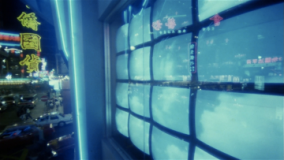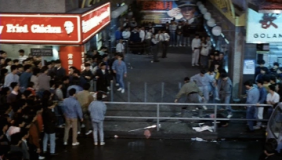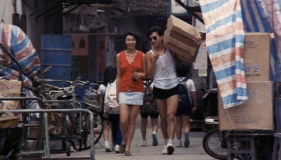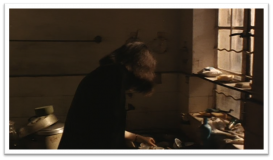
1.. 中僑國貨 Chung Kiu Commercial Building in MONG KOK

2. Tung Tin Cafe

3. Tong Cai, Sai Ying Choi in MONG KOK

4. 貝澳 PUI O IN LANTAU ISLAND

5. Interior of the Protagonist’s house
Link to the Audio Podcast & Transcript: Field Work Report
Field Report Transcript
Film: As Tears Go By (1988) by Wong Kar-Wai
E: Hi! And welcome to our podcast looking at the sites and architecture in the film As Tears Go By by Wong Kar-Wai. My name is Elinor-
J: And my name is Judy, and of particular interest to us was the contrasting spaces used in the portrayal of Hong Kong and how this mirrored and accentuated narrative or emotional aspects of the film.
E: As Tears Go By is the first film directed by Wong Kar-Wai. Perhaps one of the most well-known Hong Kong directors, he completely transformed the Hong Kong cinema scene. A member of the Second generation Hong Kong New Wave, Wong Kar-Wai’s unique cinematic style as an auteur has captured Hong Kong’s recent history and culture in a way few others have. In this film we are introduced to low-level triad member Wah and his cousin Ngor, then follow them as their romance blooms between Kowloon and Lantau Island.
J: An interpretation of Martin Scorceses’s Mean Streets from 1978, Wong Kar-Wai’s As Tears Go By adapts Mean Street’s webs of loyalty and human connection experienced in a Western landscape to the unique urban architecture of Hong Kong. Scenes of negotiation and violent exchange are often in cha chaan tengs, the Mahjong parlour (Tony ‘protects’) and densely packed streets of Mongkok while the protagonists’ sites of escape from these urban burdens are seen in journeys to and period on Lantau.
E: The biggest architectural contrast in this film is the contrast between sites of the urban- especially the city center of Mong Kok- and the rural, represented by Lantau Island. As you can see in the still shots, the protagonist’s life revolves around these two places and they both have quite different aesthetics. As a gangster, Wah’s life in Mong Kok is busy, violent and dark with the director often signaling the night life of the urban city with Hong Kong’s iconic neon signs- something gradually disappearing in our contemporary Hong Kong.
J: On the other hand, His life in Lantau island is much more peaceful. He lives with his girlfriend, there is no violence, and their interactions often happen around daytime. These contrasting representations are also manifestation of the protagonist’s psychological state. When he is in the busy urban city, he’s lively but unstable, just like what was mentioned by Ackbar Abbas about Hong Kong’s identity as the city of disappearance. However, in the underdeveloped rural area of the island, the protagonist is much happier and comfortable. By centering the storyline around two very different locations, the sense of emotional conflict is mirrored geographically, and the film’s tragic storyline is more accentuated. <
E: Another architectural choice made in the film is its contrast in population density presented on the screen. For instance, in still shot number 3 we see a lot of people within one frame- this human density on screen is visually claustrophobic and represents an almost cage-like, potentially smothering nature of the city. This is also a nod to the burdens of capital and labour responsibilities that tie us to the systems of an urban landscape, just as Wah seems tied down to his role and relationships in the city-based triad.
J: When we go back to the scenes set in Lantau island, however, the screens are pretty much focused on the protagonist and his love interest. We barely see any outsiders. This emphasizes the strong emotional connection between the two, and also emotional freedom the protagonist feels outside of the busy city, where his job almost certainly pushes him into a transient lifestyle of a gangster.
E: Lets take a closer look at one of the spaces in the film and how it is used!
The apartment in Kowloon is one of the first interior spaces we are introduced to in the cinematic space of the film. The mise en scene is dim, spartan & grimy, introducing us to Wah’s bachelor living conditions and gives us hints to how he is as a character. Mid distance shots are used throughout the film and help frame the characters in the context of their surroundings, and the tone of these surroundings in turn help emphasize the emotional state of the protagonists.
J: For example, our introduction to Ngor has these middle-distance static shots and short pans that sweep across the limited dimensions of the kitchen mixed, with occasional close shots of her coughing or in discomfort as she answers the phone or familiarises herself with the apartment. By setting the apartment up and filming it this way, Wong Kar-Wai hints at a carelessness in the lifestyle of our male protagonist Wah, while accentuating the discomfort of Ngor in her new surroundings while ill and unfamiliar with her host.
E: So, as you can see from this brief look at As Tears Go By, the architectural choices combined with narrative and cinematic techniques not only communicate an urban experience particular to Hong Kong, but also raise the presence of Hong Kong itself in the imagination of the viewer- the city taking on layers of complexity and a character of its own.
Park Junseo (UID: 3035859929)
Elinor Russell (UID: 303600042)
Your podcast analyzed the different spaces used in Wong Kar Wai’s film to represent the urban and rural, in terms of its contexts and narrative. It would help if you have structured it more thematically and investigated further, and some more images of the fieldwork you have conducted and some description of the contexts’ condition in reality.